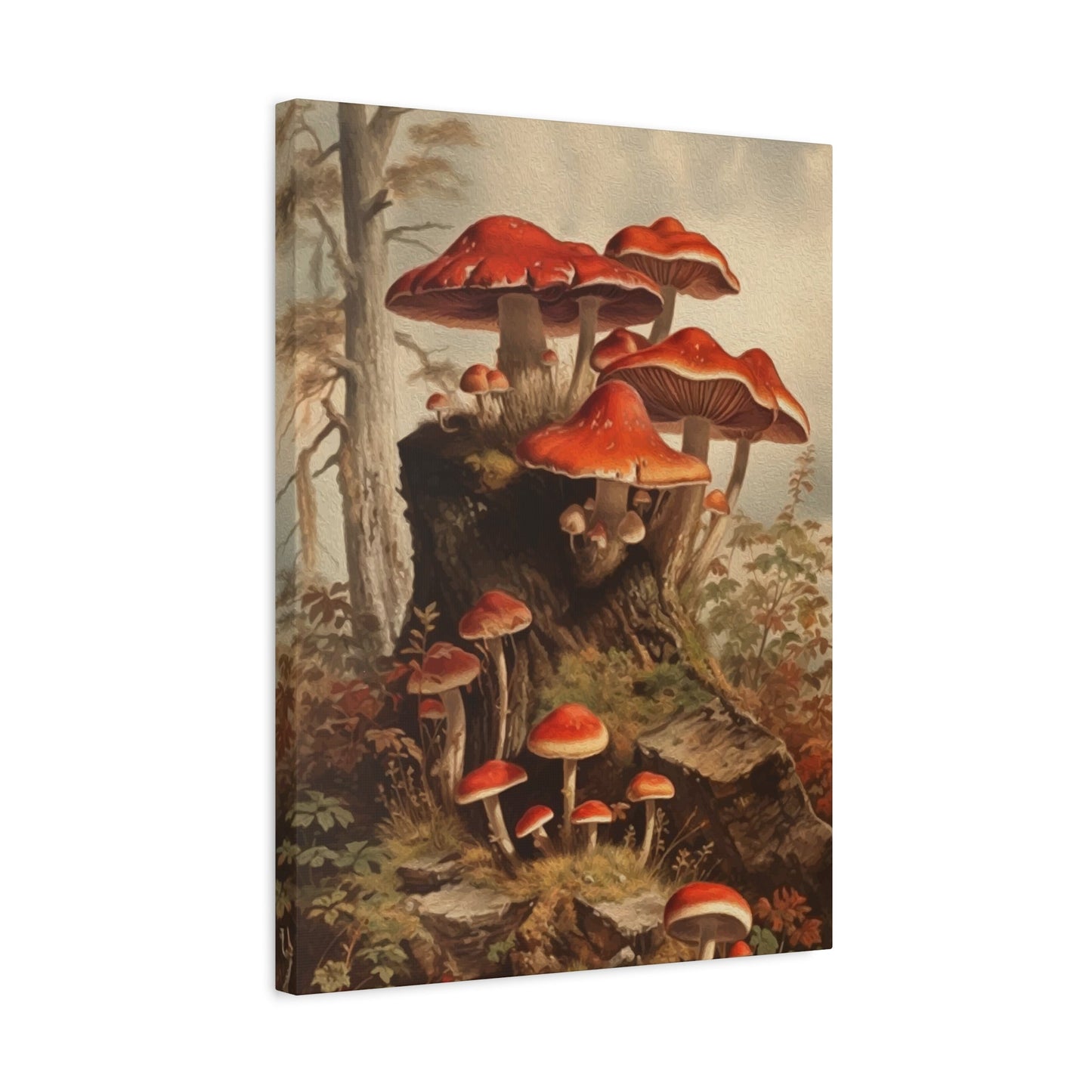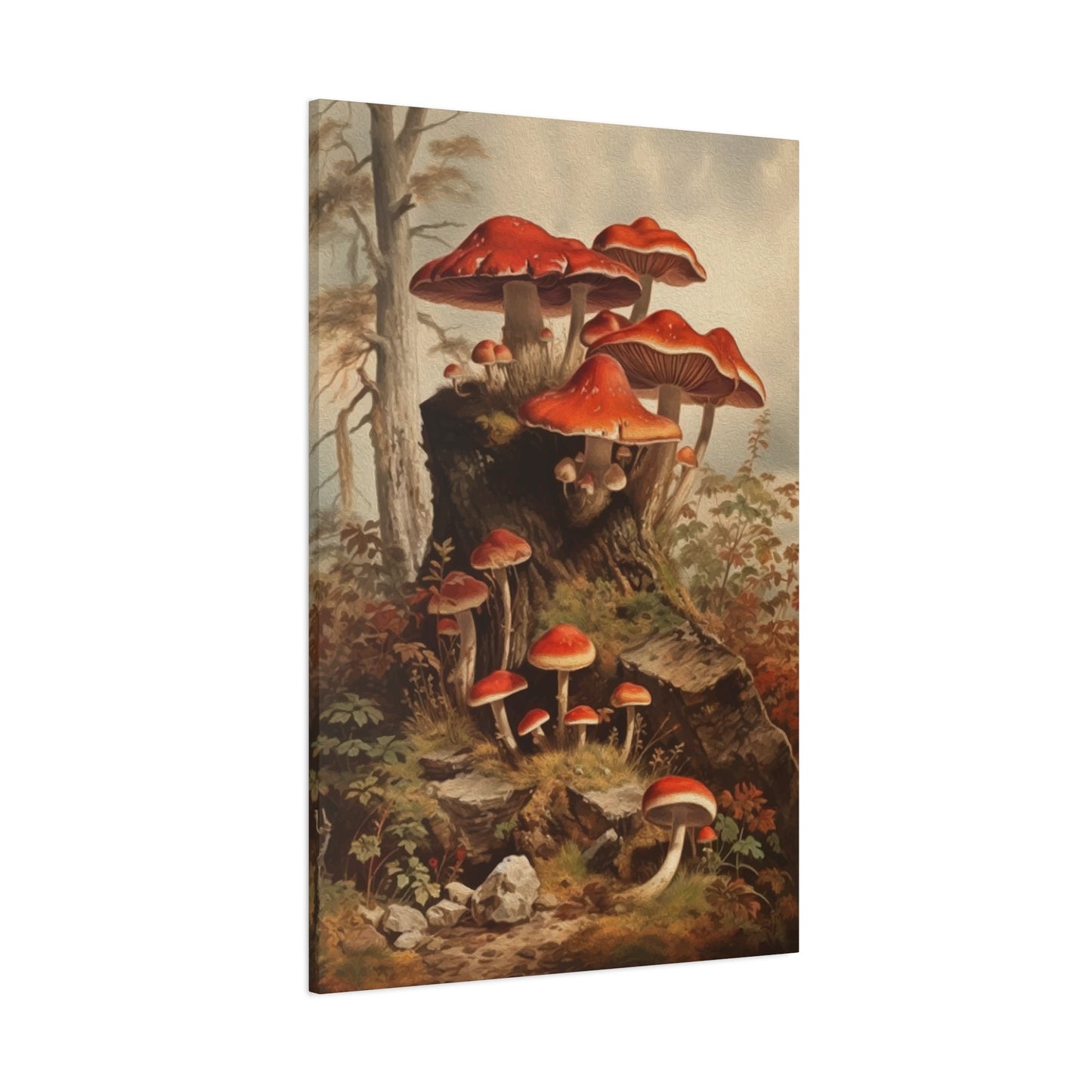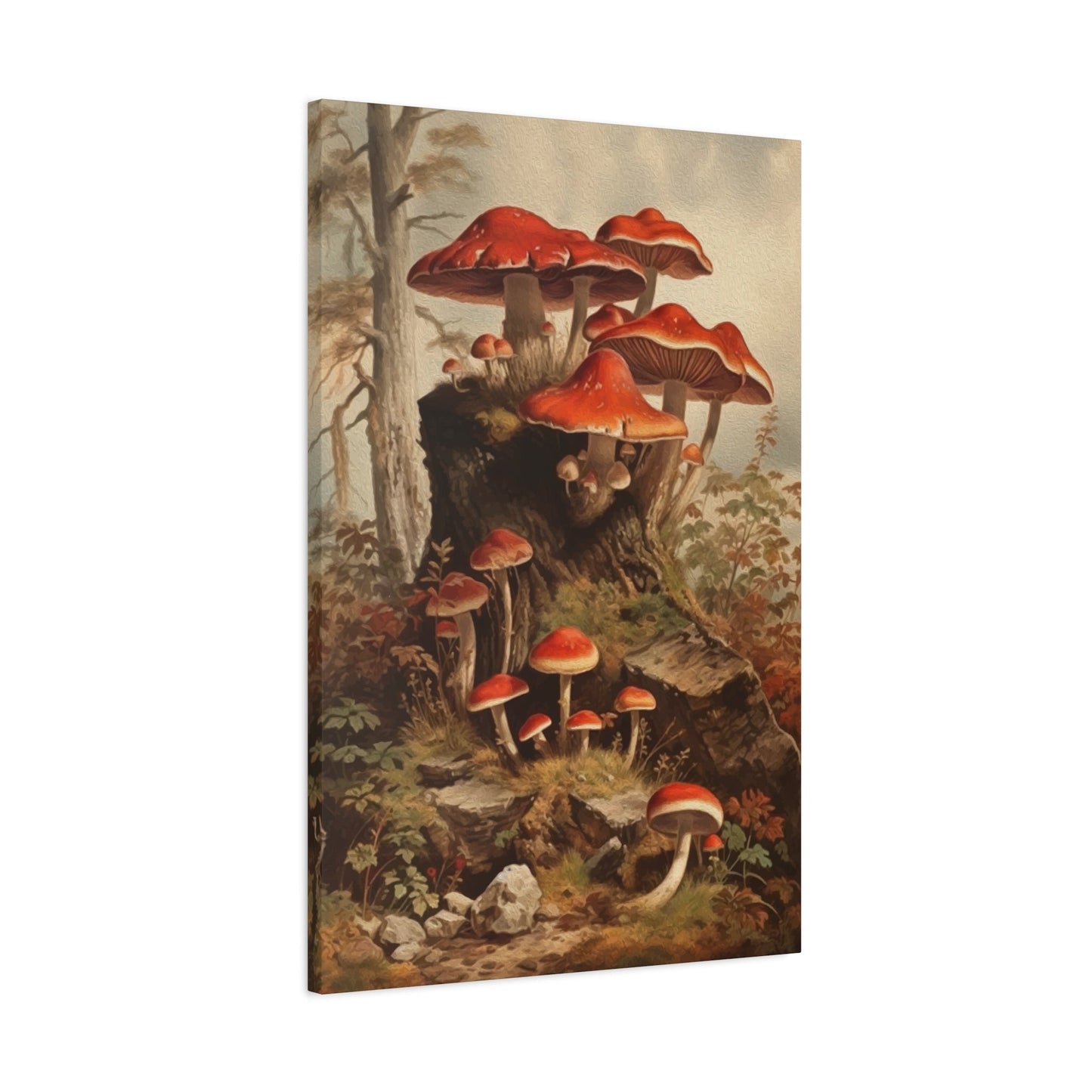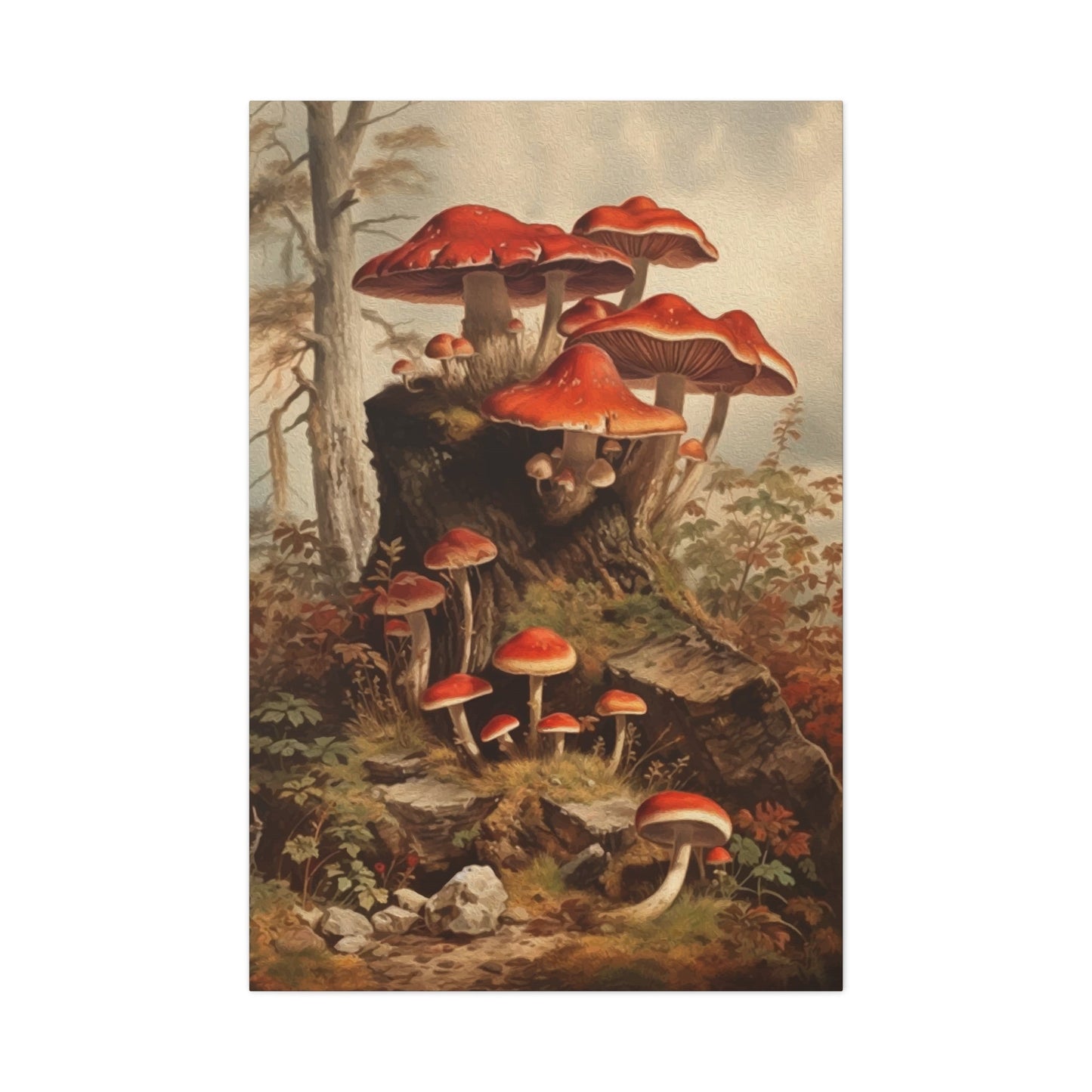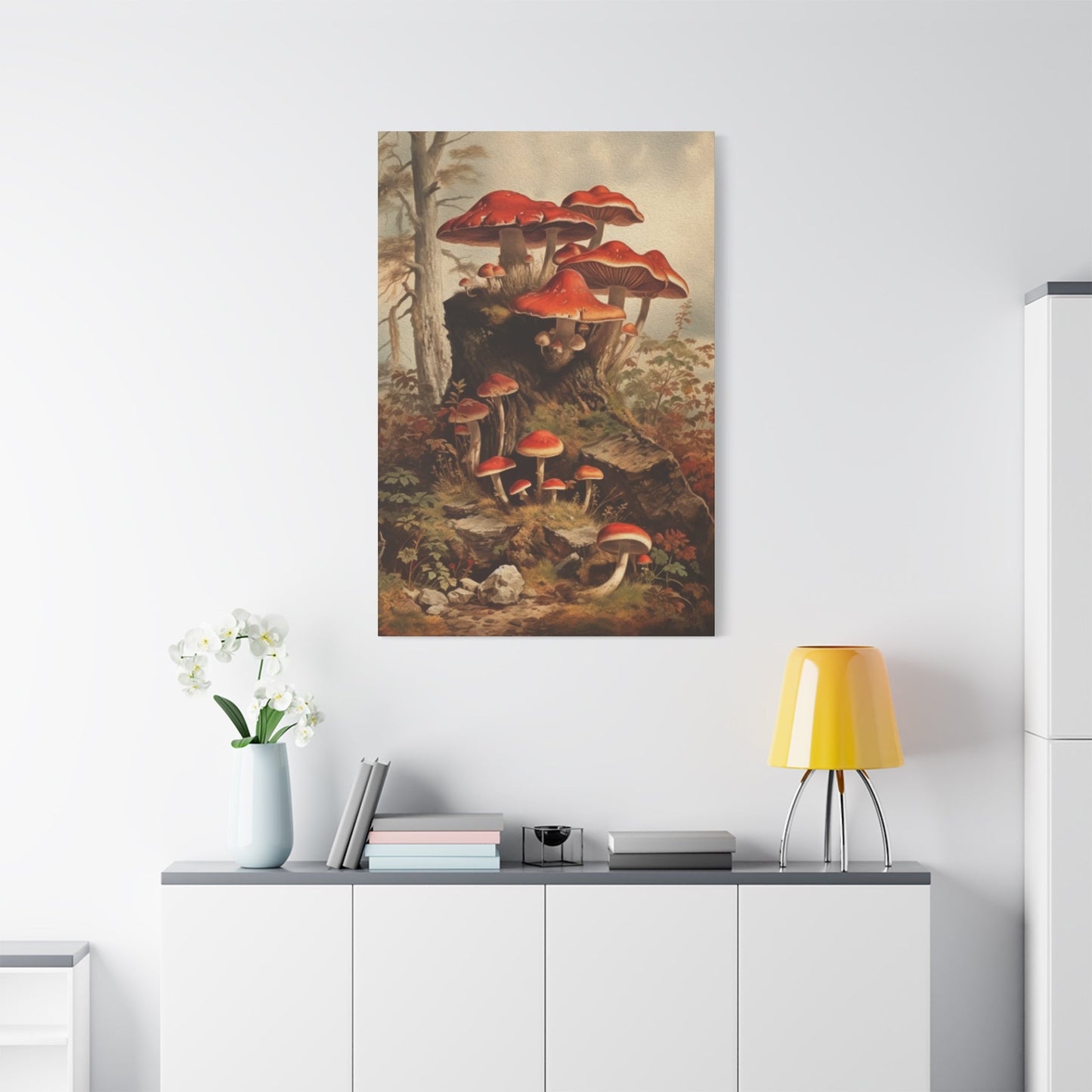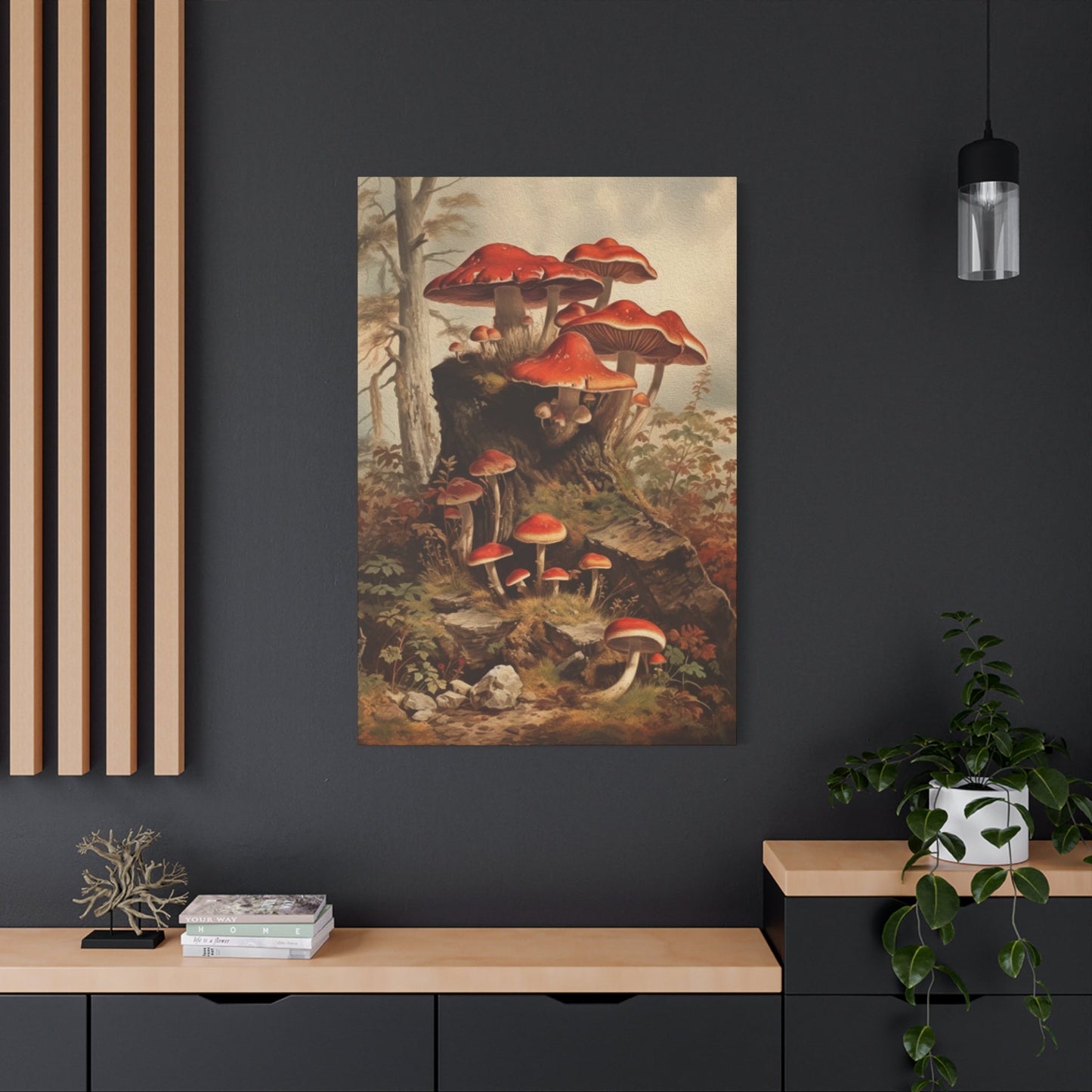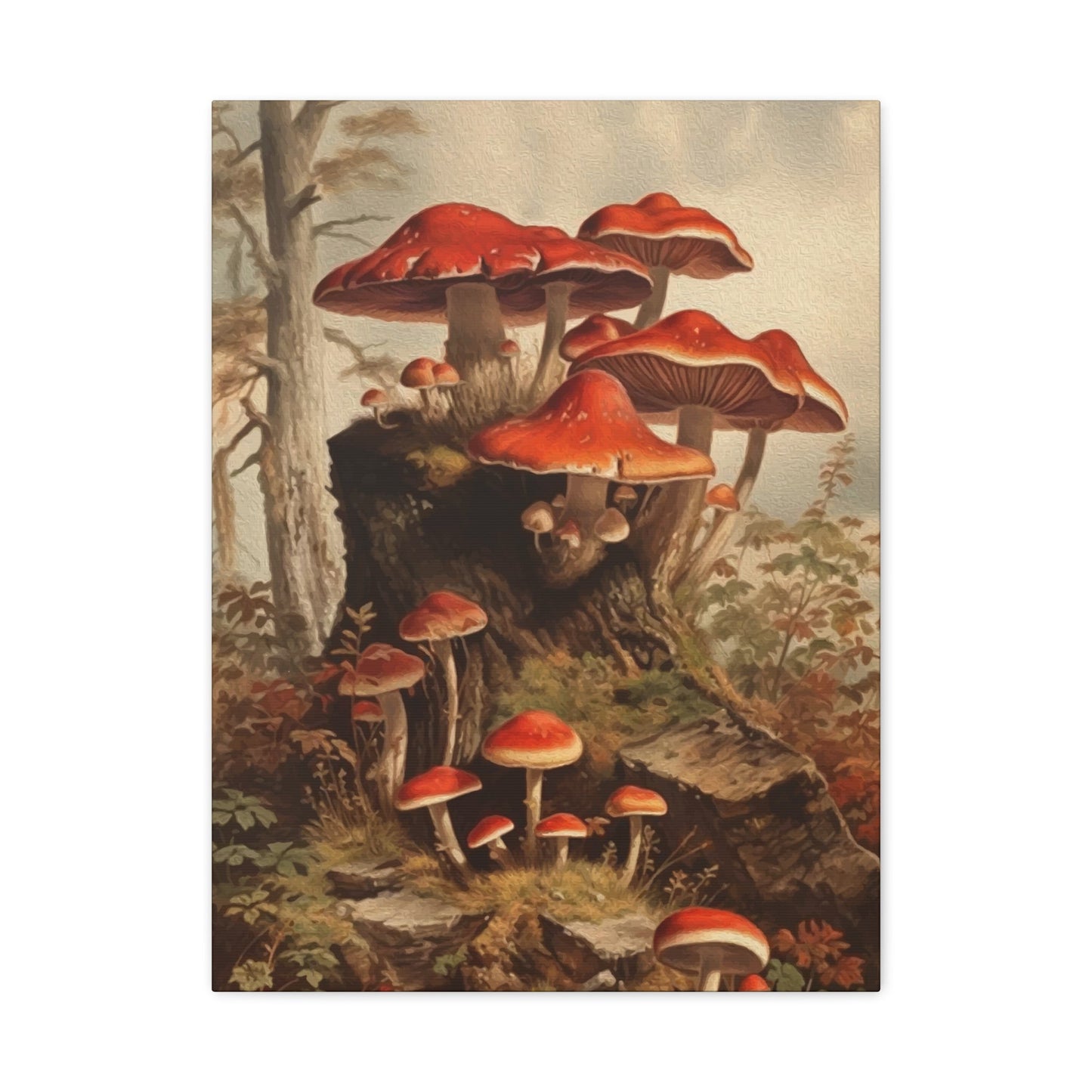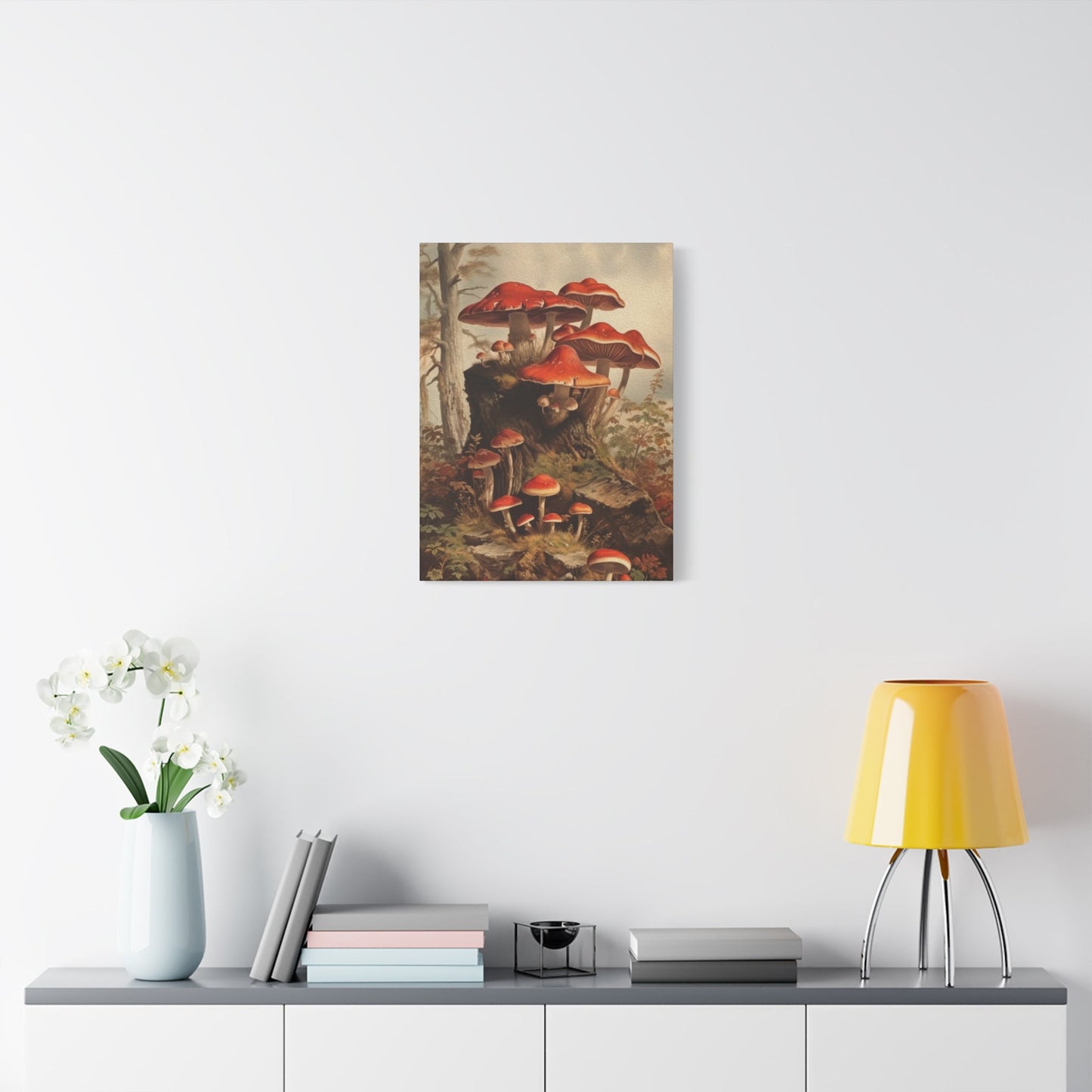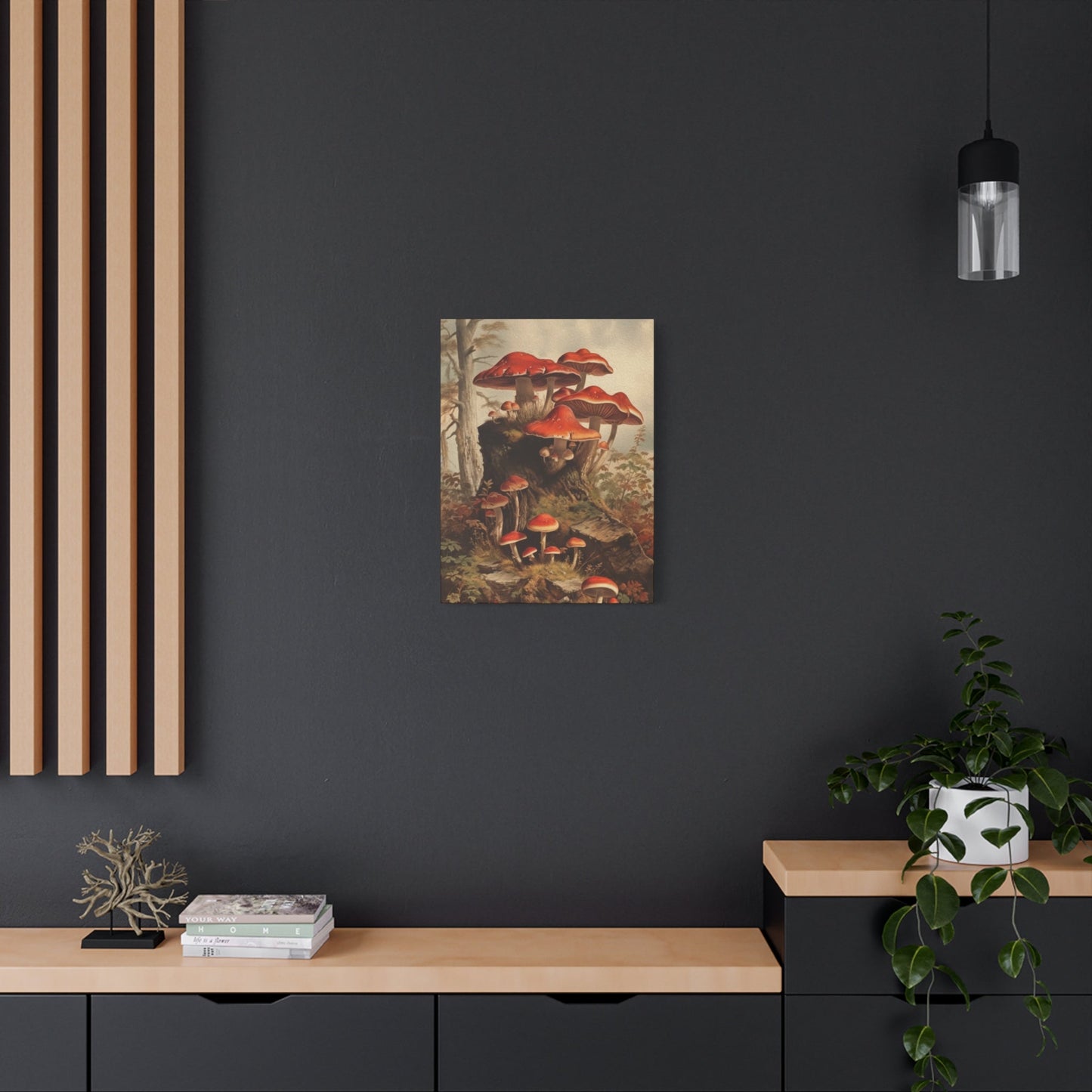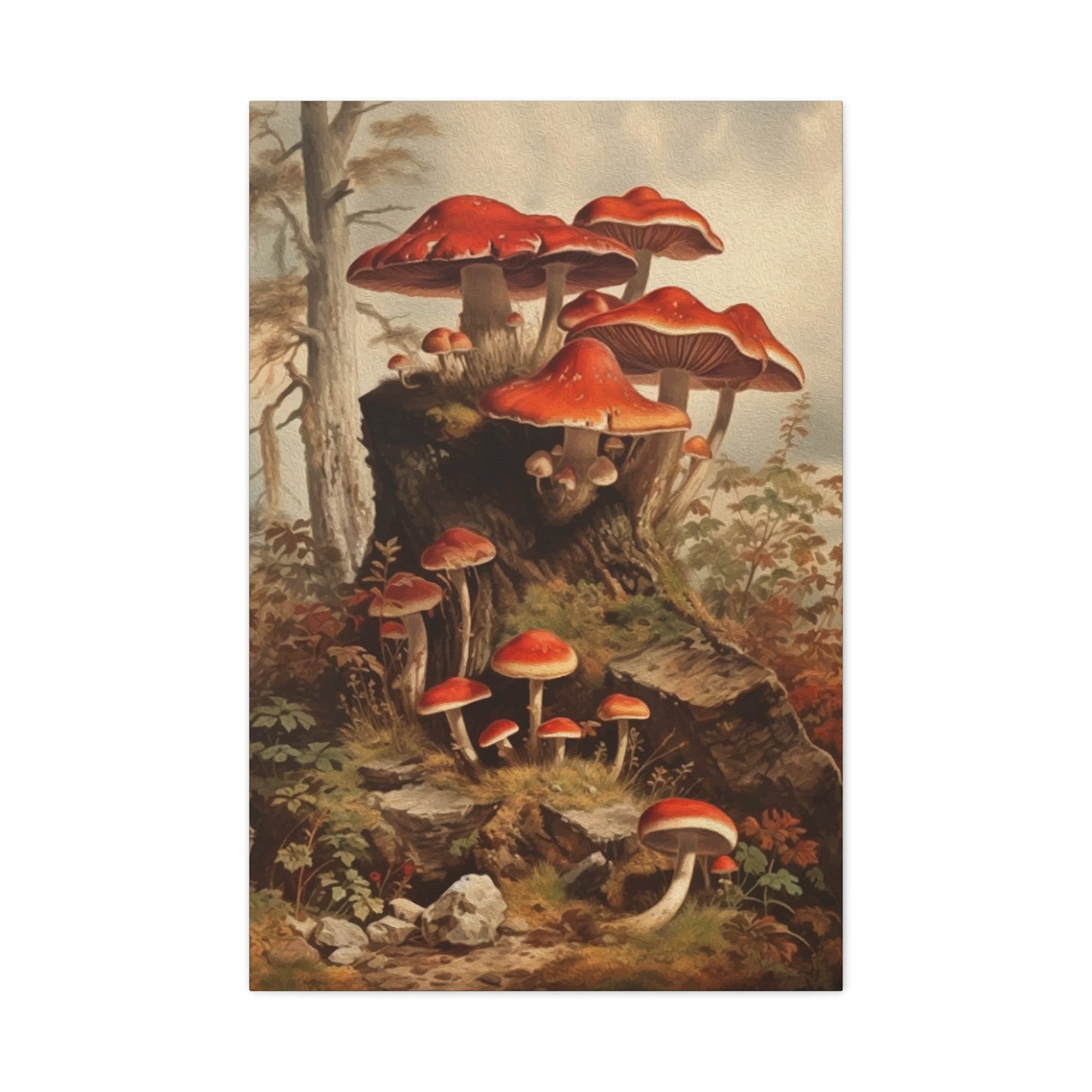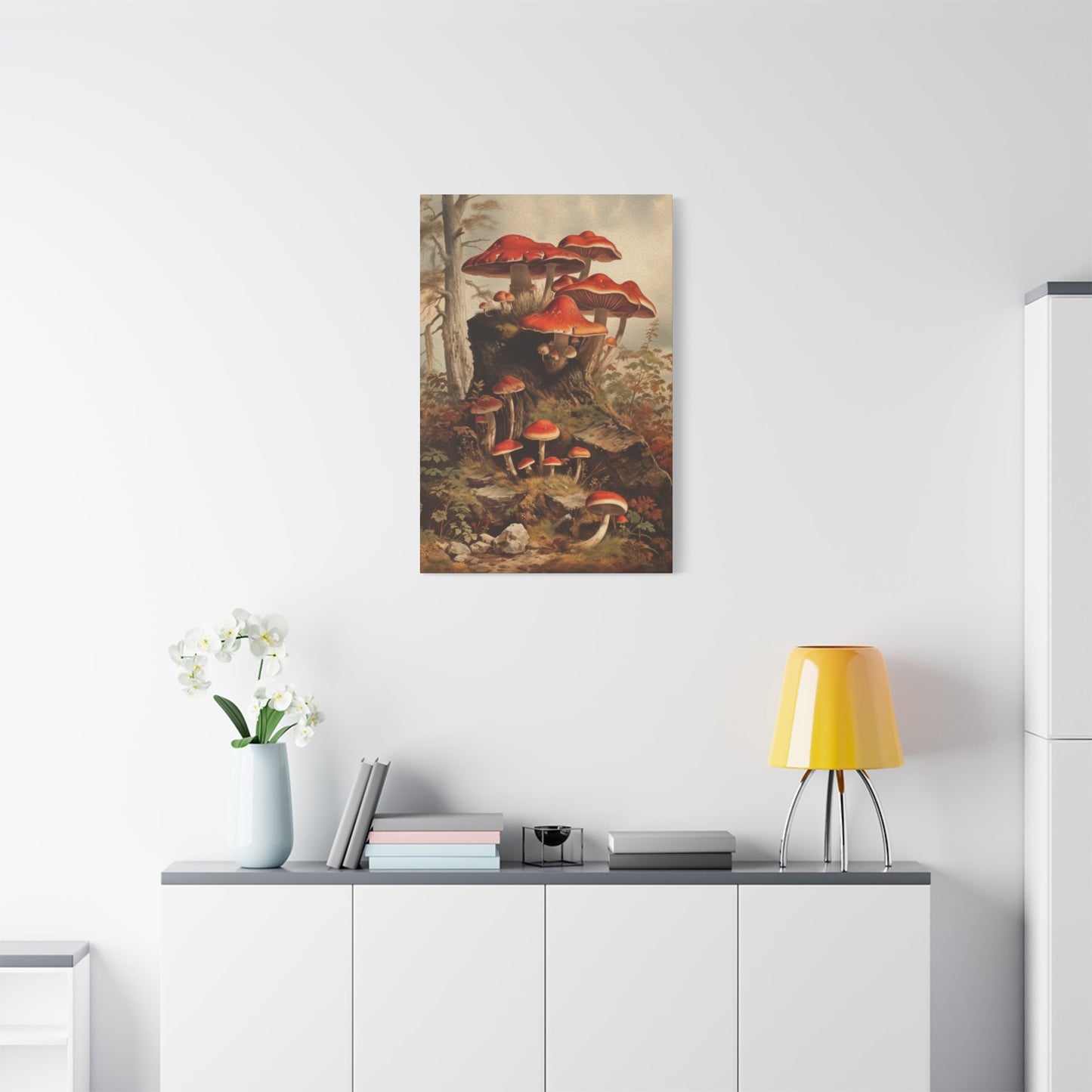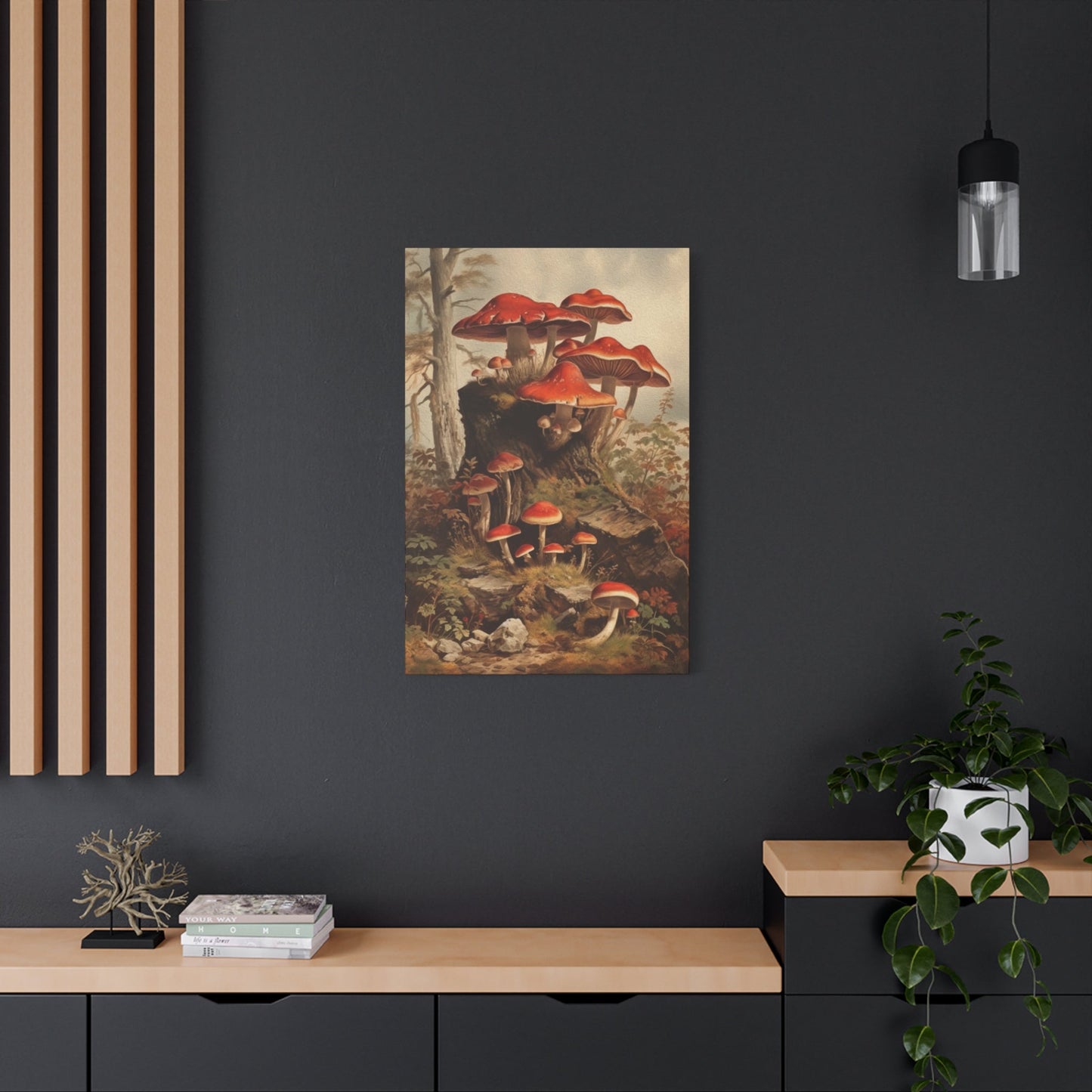The Ultimate Guide to Transforming Your Home with Enchanting Mushroom Wall Art
The world of home decoration has witnessed a remarkable surge in nature-inspired themes, with fungi-themed artwork emerging as one of the most captivating trends of recent years. These botanical masterpieces bring an extraordinary blend of whimsy, sophistication, and natural beauty into any living environment. From delicate watercolor illustrations to bold contemporary prints, mushroom wall art offers homeowners an opportunity to create truly unique and memorable atmospheres that celebrate the fascinating world of mycology while enhancing the aesthetic appeal of their homes.
The growing popularity of these artistic pieces stems from their incredible versatility and the profound connection they establish between indoor environments and the natural world. Whether you're drawn to the mystical qualities often associated with fungi or simply appreciate their unique forms and textures, incorporating these elements into your home can create transformative results that captivate guests and provide daily inspiration for residents.
The Natural Allure of Mushroom Wall Art
Nature has always served as humanity's greatest source of artistic inspiration, and fungi represent one of the most intriguing subjects within the botanical realm. These remarkable organisms possess an inherent beauty that transcends conventional decorative boundaries, offering viewers a glimpse into the mysterious and often overlooked world that exists beneath forest floors and in hidden corners of the natural environment.
The appeal of mushroom-themed artwork lies in its ability to capture the delicate balance between the familiar and the extraordinary. While most people encounter various fungi species in their daily lives, few take the time to truly appreciate the intricate details, subtle color variations, and elegant forms that make each specimen unique. When translated into wall art, these characteristics become magnified and celebrated, allowing viewers to discover new levels of appreciation for these often-underestimated organisms.
Contemporary artists have embraced fungi as subject matter for numerous reasons, not least of which is the incredible diversity found within the mushroom kingdom. From the classic red and white spotted varieties that appear in fairy tales to the more exotic species with unusual shapes and vibrant colorations, there exists an almost endless array of visual possibilities for creative expression. This diversity ensures that mushroom wall art can complement virtually any decorative scheme, from minimalist modern environments to more traditional or eclectic settings.
The scientific accuracy often found in botanical illustrations of fungi adds an educational component to these decorative pieces, making them particularly appealing to those who appreciate both beauty and knowledge in their home furnishings. Many artists collaborate with mycologists to ensure their representations are botanically correct, resulting in artwork that serves dual purposes as both decoration and reference material.
The textural qualities inherent in mushroom subjects translate beautifully into various artistic mediums, from detailed pen and ink drawings that emphasize the intricate gill patterns found on mushroom undersides to bold acrylic paintings that capture the smooth, sometimes glossy surfaces of mushroom caps. These varied textural elements add visual interest and depth to any room, creating focal points that invite closer examination and contemplation.
Color palettes associated with mushroom art tend to be both sophisticated and versatile, ranging from earthy neutrals that complement natural wood furnishings to more vibrant hues that can serve as accent pieces in contemporary settings. The natural occurrence of unusual colors in certain mushroom species, such as the brilliant blue of some Lactarius varieties or the deep purple of certain Cortinarius species, provides artists with justification for incorporating bold, unexpected colors into their work while maintaining botanical accuracy.
Whimsical and Wild: Mushrooms in Home Decor
The incorporation of fungi-themed elements into home decoration represents a departure from conventional botanical subjects, offering homeowners an opportunity to express personality and creativity through unexpected choices. Unlike traditional floral motifs or common plant subjects, mushroom art immediately signals a household that values uniqueness and isn't afraid to embrace the unconventional aspects of natural beauty.
The whimsical nature of many mushroom species lends itself naturally to playful and imaginative decorative applications. The fairy ring formation of certain fungi species has inspired countless artistic interpretations that capture the magical qualities often associated with these organisms in folklore and popular culture. These artistic representations can transform ordinary rooms into enchanted environments that spark imagination and conversation among visitors and residents alike.
Wild mushroom varieties offer particularly striking visual elements for home decoration, with their often dramatic forms and unexpected color combinations providing inspiration for bold artistic statements. The shelf-like projections of bracket fungi, the intricate branching patterns of coral fungi, and the otherworldly appearance of bird's nest fungi all translate into compelling artistic subjects that challenge conventional notions of botanical beauty.
The seasonal aspects of mushroom growth and appearance provide opportunities for rotating decorative displays that reflect the changing character of natural environments throughout the year. Spring morel illustrations can give way to summer chanterelle prints, followed by autumn displays featuring the rich browns and golds associated with fall fungi harvests, creating dynamic decorative schemes that evolve with the natural calendar.
Many contemporary artists have embraced the surreal qualities inherent in certain mushroom species, creating works that blur the lines between scientific illustration and fantasy art. These pieces appeal to viewers who appreciate both natural beauty and imaginative interpretation, resulting in decorative elements that function as conversation starters and sources of daily inspiration.
The cultural associations between mushrooms and various mythological and literary traditions provide rich thematic material for decorative applications. From the mushroom houses depicted in children's literature to the sacred fungi referenced in various spiritual traditions, these cultural connections add layers of meaning to mushroom-themed artwork that extend beyond mere aesthetic appreciation.
The growing interest in foraging and wild food preparation has contributed to the popularity of mushroom-themed home decoration, as homeowners seek to express their connection to traditional food gathering practices and sustainable living philosophies through their decorative choices. This trend reflects a broader cultural movement toward reconnecting with natural processes and traditional knowledge systems.
Top Styles of Mushroom-Themed Canvas Prints
Canvas prints featuring mushroom subjects have gained tremendous popularity due to their ability to showcase the intricate details and rich textures that make fungi such compelling artistic subjects. The canvas medium provides an ideal surface for capturing the subtle gradations of color and form that characterize many mushroom species, while offering durability and versatility that make these pieces suitable for various home environments.
Photorealistic canvas prints represent one of the most popular approaches to mushroom-themed artwork, utilizing high-resolution photography and advanced printing techniques to create images that capture every detail of their subjects with stunning clarity. These pieces appeal to viewers who appreciate scientific accuracy and want to bring the precise beauty of natural mushroom specimens into their homes without the maintenance requirements of living plants or the fragility of dried specimens.
Watercolor-style canvas prints offer a softer, more interpretive approach to mushroom subjects, utilizing the translucent qualities of watercolor techniques to create dreamy, atmospheric representations that emphasize mood and feeling over precise botanical detail. These pieces work particularly well in bedrooms and other relaxation areas where a gentle, calming aesthetic is desired.
Abstract interpretations of mushroom forms have found favor among homeowners who prefer contemporary art styles that suggest rather than literally depict their natural subjects. These pieces often focus on the essential shapes, colors, and patterns found in mushroom specimens while allowing artistic interpretation to transform these elements into more stylized compositions that complement modern decorative schemes.
Vintage botanical illustration styles have experienced a renaissance in mushroom-themed canvas prints, with many contemporary artists drawing inspiration from the detailed scientific illustrations of the 18th and 19th centuries. These pieces combine historical aesthetic sensibilities with modern printing technologies to create artwork that feels both timeless and contemporary, appealing to those who appreciate classical artistic traditions.
Mixed media approaches to mushroom canvas prints often incorporate collage elements, textural additions, or combinations of different artistic techniques to create layered, complex compositions that reward detailed examination. These pieces work particularly well in eclectic decorative schemes where visual complexity and artistic innovation are valued.
Large-format canvas prints featuring mushroom subjects can serve as dramatic focal points in living rooms, dining areas, or other spaces where bold artistic statements are appropriate. The scalability of canvas printing technology allows for mushroom artwork to be produced in sizes that command attention while maintaining the detail and clarity that make these subjects so visually compelling.
Series approaches to mushroom canvas prints, featuring multiple related pieces designed to be displayed together, offer opportunities for creating comprehensive decorative themes that can transform entire walls or room sections. These collections might focus on different species, seasonal variations, or various artistic interpretations of similar subjects, providing cohesive yet varied visual experiences.
Mushroom Wall Art for Nature Lovers
Individuals with deep appreciation for natural environments find mushroom-themed wall art particularly compelling due to its representation of one of nature's most fascinating and essential biological processes. Fungi play crucial ecological roles as decomposers and symbiotic partners with other organisms, making them perfect subjects for those who understand and value natural interconnectedness and environmental stewardship.
The educational aspects of mushroom wall art appeal strongly to nature enthusiasts who enjoy learning about different species, their habitats, and their ecological functions while simultaneously decorating their homes. Many high-quality mushroom prints include species names, habitat information, and other educational details that transform decorative pieces into learning resources that can inspire further exploration of mycological subjects.
Field guide aesthetics have influenced many mushroom wall art pieces, creating artwork that captures the systematic, scientific approach to species identification while maintaining artistic appeal. These pieces often feature multiple species arranged in taxonomic groupings or habitat-based collections, providing viewers with comprehensive overviews of mushroom diversity while creating visually organized and educationally valuable displays.
Habitat-focused mushroom artwork allows nature lovers to bring specific ecological environments into their homes through artistic representation. Pieces depicting forest floor scenes with mushrooms in their natural contexts, or artwork showing the relationship between fungi and their host trees, create connections between indoor decorative elements and outdoor natural experiences that resonate with those who spend time in natural environments.
Seasonal mushroom collections appeal to nature lovers who appreciate the temporal aspects of natural cycles and want their home decoration to reflect the changing character of outdoor environments throughout the year. These collections might feature spring ephemeral species, summer abundance, autumn harvest varieties, and winter shelf fungi, creating dynamic displays that evolve with natural rhythms.
Conservation themes in mushroom wall art resonate with environmentally conscious homeowners who want their decorative choices to reflect their values regarding habitat protection and biodiversity preservation. Artwork featuring rare or endangered mushroom species can serve as conversation starters about conservation issues while providing beautiful decorative elements that support important environmental messages.
The medicinal and nutritional aspects of certain mushroom species provide additional layers of meaning for nature lovers who appreciate the practical as well as aesthetic values of fungi. Artwork featuring species with known health benefits or culinary applications can serve as inspiration for foraging activities, gardening projects, or simply as reminders of the many ways humans can benefit from understanding and respecting natural systems.
Photography-based mushroom wall art often appeals to nature lovers who appreciate the documentary aspects of capturing natural subjects in their native environments. These pieces can transport viewers to specific locations and moments, creating connections between home environments and remembered or anticipated outdoor experiences that enhance the emotional resonance of decorative elements.
Cottagecore Vibes with Mushroom Art
The cottagecore aesthetic movement has embraced mushroom-themed artwork as a perfect expression of its core values, which center around romanticized rural living, traditional crafts, and harmonious relationships with natural environments. Mushroom art fits seamlessly into this aesthetic framework by representing the quiet, often overlooked beauty found in natural settings and embodying the cottagecore emphasis on finding magic in simple, everyday natural phenomena.
Soft, muted color palettes characteristic of cottagecore decorating find perfect expression in mushroom artwork that emphasizes earth tones, gentle pastels, and the subtle color variations naturally found in fungi specimens. These pieces create atmospheric qualities that support the cottagecore goal of establishing peaceful, contemplative home environments that feel removed from modern urban stresses and complications.
Hand-drawn illustration styles particularly complement cottagecore themes, as they suggest the traditional artistic practices and handcrafted elements that are central to this aesthetic movement. Mushroom artwork created using watercolors, colored pencils, or pen and ink techniques evokes the kind of nature journaling and botanical illustration practices that cottagecore enthusiasts often aspire to incorporate into their own lives.
The foraging associations connected with many edible mushroom species align perfectly with cottagecore values regarding self-sufficiency, traditional knowledge, and sustainable living practices. Artwork depicting chanterelles, morels, oyster mushrooms, and other edible varieties can serve as inspiration for foraging activities while creating decorative elements that celebrate traditional food gathering practices and seasonal eating patterns.
Fairy tale and folklore connections associated with mushrooms provide rich thematic material for cottagecore decorating schemes. Artwork depicting mushroom fairy houses, woodland scenes with fungi elements, or illustrations inspired by traditional stories featuring mushrooms can create the whimsical, magical atmosphere that cottagecore enthusiasts seek to establish in their homes.
Vintage botanical print aesthetics work particularly well within cottagecore decorating schemes, as they suggest the kind of historical domestic practices and traditional knowledge systems that this movement celebrates. Mushroom artwork created in the style of 19th-century botanical illustrations or field guides can provide authentic period aesthetics while incorporating subjects that feel fresh and unexpected.
Pressed flower and botanical specimen aesthetics can be adapted to mushroom subjects, creating artwork that suggests the kind of nature collecting and preserving activities that are popular within cottagecore communities. Even though actual mushroom preservation is more challenging than flower pressing, artwork that evokes these traditional practices can provide similar aesthetic and emotional effects.
The therapeutic and meditative aspects of observing and appreciating mushroom subjects align with cottagecore values regarding mindfulness, simple pleasures, and finding contentment in quiet activities. Mushroom wall art can serve as focal points for contemplation and reflection, supporting the cottagecore goal of creating home environments that promote mental wellness and spiritual connection with natural elements.
Abstract vs Realistic Mushroom Paintings
The artistic interpretation of mushroom subjects spans a wide spectrum from highly detailed, scientifically accurate representations to completely abstracted compositions that use fungi forms as starting points for creative exploration. This range of approaches offers homeowners diverse options for incorporating mushroom themes into their decorative schemes while accommodating different aesthetic preferences and artistic sensibilities.
Realistic mushroom paintings focus on accurate representation of specific species, often incorporating detailed attention to anatomical features, accurate coloration, and precise rendering of textures and surface characteristics. These pieces appeal to viewers who appreciate botanical accuracy and want artwork that could serve educational purposes while providing decorative value. The challenge for artists working in realistic styles lies in capturing the often subtle beauty of mushroom subjects while maintaining scientific accuracy and creating compositions that work effectively as decorative elements.
Photorealistic techniques in mushroom painting have been enhanced by digital tools and advanced artistic techniques that allow for incredible detail and precision in rendering natural subjects. These paintings can achieve levels of detail that rival high-quality photography while maintaining the unique qualities that distinguish painted artwork from photographic reproductions. The time and skill required to create truly photorealistic mushroom paintings often make these pieces valuable investments that can serve as focal points in sophisticated decorative schemes.
Abstract interpretations of mushroom subjects offer artists and homeowners opportunities to explore the essential visual elements of fungi forms without being constrained by requirements for botanical accuracy. Abstract mushroom paintings might focus on color relationships, geometric patterns derived from mushroom structures, or emotional responses to natural subjects, creating artwork that suggests rather than literally depicts its inspirational sources.
Impressionistic approaches to mushroom painting capture the atmospheric qualities and overall feeling of encountering fungi in natural settings rather than focusing on precise detail. These pieces often emphasize light effects, color relationships, and the integration of mushroom subjects with their surrounding environments, creating artwork that evokes specific moods and emotional responses rather than providing documentary information.
Expressionistic mushroom paintings use fungi subjects as vehicles for exploring broader themes, emotions, or artistic concepts, often employing exaggerated colors, dramatic brushwork, or unconventional compositions to create powerful visual statements. These pieces can transform familiar natural subjects into vehicles for personal expression and artistic exploration that resonates with viewers on emotional rather than purely aesthetic levels.
Stylized approaches to mushroom painting often incorporate elements from various artistic traditions, cultural motifs, or decorative styles to create compositions that blend natural subjects with human cultural expressions. These pieces might incorporate Art Nouveau flowing lines, Art Deco geometric elements, or folk art traditions to create unique synthetic works that appeal to viewers interested in both natural subjects and cultural artistic traditions.
Mixed media mushroom paintings combine traditional painting techniques with collage elements, textural additions, or digital enhancements to create complex, layered compositions that reward detailed examination. These pieces often work well in contemporary decorative schemes where visual complexity and artistic innovation are valued, and they can serve as conversation pieces that reveal new details with repeated viewing.
Using Mushroom Art in Kids' and Play Rooms
Children's environments provide ideal settings for mushroom-themed artwork due to the natural sense of wonder and curiosity that young people often display when encountering these fascinating natural subjects. The whimsical qualities inherent in many mushroom species, combined with their frequent appearances in children's literature and fairy tales, make fungi-themed artwork particularly appropriate for nurseries, bedrooms, playrooms, and other child-focused environments.
Educational opportunities abound when incorporating mushroom art into children's rooms, as these pieces can serve as starting points for conversations about nature, biology, ecology, and the natural world. High-quality mushroom artwork with accurate species representations can introduce children to scientific concepts while providing beautiful decorative elements that grow with them as they develop increased appreciation for natural subjects and scientific understanding.
Safety considerations are paramount when selecting artwork for children's environments, making professionally framed and properly mounted pieces essential for mushroom wall art in these applications. Canvas prints, laminated posters, and other durable formats work particularly well in active play environments where artwork might be subjected to impact or moisture exposure.
Color psychology plays an important role in children's room decoration, and mushroom artwork often features the earth tones and natural color palettes that child development experts recommend for creating calming, grounding influences in young people's environments. The organic forms and natural colors found in mushroom art can help balance the often bright, stimulating elements common in children's toys and furnishings.
Interactive elements can be incorporated into mushroom-themed children's room decoration through artwork that encourages close examination, counting activities, or identification games. Pieces featuring multiple species, hidden details, or seasonal variations can provide ongoing entertainment and learning opportunities that keep children engaged with their room decoration over extended periods.
Growth and development themes inherent in mushroom life cycles provide excellent metaphorical material for children's room decoration, as these natural processes can serve as gentle introductions to concepts of change, growth, and natural cycles. Artwork depicting mushroom development stages or seasonal appearance patterns can create connections between home decoration and broader life lessons that support children's emotional and intellectual development.
Fantasy and imagination elements associated with mushrooms in popular culture provide opportunities for creating playful, magical atmospheres in children's rooms through carefully selected artwork. Pieces that evoke fairy tale settings, magical forests, or whimsical natural environments can stimulate creativity and imaginative play while maintaining connections to real natural subjects.
Age-appropriate content considerations are important when selecting mushroom artwork for children's rooms, as some fungi species have cultural associations that may not be suitable for young audiences. Focusing on commonly encountered, benign species and avoiding artwork that emphasizes potentially dangerous or psychoactive varieties ensures that decorative choices remain appropriate for child-focused environments.
Symbolism of Mushrooms in Wall Decor
Throughout human history, mushrooms have carried rich symbolic meanings across diverse cultures, spiritual traditions, and artistic movements, making fungi-themed wall art particularly meaningful for homeowners who appreciate layers of significance in their decorative choices. Understanding these symbolic associations can enhance the emotional resonance and personal significance of mushroom artwork while adding depth to home decoration that extends beyond mere aesthetic appreciation.
Transformation and renewal represent perhaps the most universal symbolic associations with mushrooms, as these organisms play crucial ecological roles in breaking down dead organic matter and converting it into nutrients that support new life. Wall art featuring mushrooms can serve as powerful reminders of natural cycles, personal growth, and the positive potential inherent in times of change or transition.
Mystery and hidden knowledge have long been associated with mushrooms due to their often secretive growth patterns, their sudden appearance after rain, and the specialized knowledge required to safely identify and utilize various species. Mushroom wall art can symbolize wisdom, learning, and the value of patient observation and study, making these pieces particularly meaningful for home offices, libraries, or other environments dedicated to intellectual pursuits.
Connection to earth and natural cycles makes mushroom symbolism particularly powerful for those seeking to establish stronger relationships with natural environments and seasonal rhythms. Artwork featuring mushrooms can serve as daily reminders of the complex ecological relationships that support all life while encouraging mindfulness about human relationships with natural systems.
Spiritual and consciousness-expanding associations with certain mushroom species have deep historical roots in various cultural traditions, making fungi-themed artwork meaningful for those interested in meditation, spiritual growth, or consciousness exploration. While avoiding specific references to psychoactive properties, mushroom art can subtly evoke themes of expanded awareness, spiritual seeking, and inner exploration.
Abundance and nourishment symbolism connected with edible mushroom varieties can make fungi-themed wall art particularly appropriate for kitchens, dining rooms, or other areas associated with food preparation and sharing. These pieces can celebrate the bounty of natural foods while honoring traditional foraging practices and seasonal eating patterns that connect human communities with local ecosystems.
Resilience and adaptation themes inherent in mushroom biology provide inspiring symbolic content for home decoration, as fungi demonstrate remarkable abilities to thrive in challenging conditions and find creative solutions to environmental obstacles. Wall art featuring hardy mushroom species can serve as inspiration during difficult times while celebrating the resourcefulness and persistence that characterize both natural systems and human communities.
Hidden beauty and unexpected discovery symbolism associated with mushrooms reflects the way these organisms often reveal their presence gradually and reward careful observation with glimpses of remarkable beauty in overlooked places. Mushroom wall art can encourage viewers to develop greater appreciation for subtle beauty and find magic in everyday natural phenomena that might otherwise escape notice.
Combining Mushrooms with Forest and Wildlife Themes
The natural habitat associations of most mushroom species provide excellent opportunities for creating comprehensive decorative themes that celebrate entire forest ecosystems and the complex relationships between fungi and other woodland organisms. These integrated approaches to nature-themed wall art can transform rooms into immersive natural environments that educate viewers about ecological connections while providing beautiful, cohesive decorative schemes.
Forest floor compositions featuring mushrooms in context with fallen leaves, moss, ferns, and other woodland elements create realistic habitat representations that help viewers understand the ecological roles of fungi while providing visually rich decorative elements. These complex compositions often work particularly well as large-format pieces that can serve as focal points in living rooms, dining areas, or other spaces where detailed artwork can be properly appreciated.
Wildlife interactions with mushroom species provide fascinating subjects for nature-themed wall art, as many animals depend on fungi for food, shelter, or other ecological services. Artwork depicting squirrels gathering mushrooms, deer browsing on shelf fungi, or insects living in mushroom habitats can illustrate the interconnectedness of forest communities while creating engaging decorative elements that appeal to wildlife enthusiasts.
Tree and mushroom relationships offer particularly compelling subjects for nature-themed artwork, as many fungi species form essential partnerships with tree roots or depend on dead wood for their survival. Pieces that show these relationships accurately can serve educational purposes while creating visually striking compositions that work well in rustic or natural decorative schemes.
Seasonal forest themes incorporating mushroom elements can create dynamic decorative displays that change with natural rhythms and reflect the temporal aspects of woodland ecosystems. Spring ephemeral mushrooms, summer abundance, autumn harvest varieties, and winter bracket fungi can be featured in rotating displays that keep nature-themed decoration fresh and engaging throughout the year.
Bird and mushroom combinations work particularly well in nature-themed wall art, as many bird species consume fungi or use mushroom materials in nest construction. Artwork featuring woodland birds in mushroom-rich environments can appeal to birdwatchers while creating balanced compositions that celebrate multiple aspects of forest biodiversity.
Insect and mushroom relationships provide opportunities for detailed, scientifically accurate artwork that can fascinate viewers interested in the smaller inhabitants of natural environments. Many insects depend on mushrooms for food or breeding sites, and these relationships can be depicted in artwork that combines aesthetic appeal with educational value.
Botanical combinations featuring mushrooms with wildflowers, ferns, mosses, and other forest plants can create comprehensive habitat representations that showcase the full complexity of woodland ecosystems. These multi-element compositions often work well as series pieces that can be displayed together to create immersive natural environments in home settings.
How to Frame and Style Mushroom Prints
The presentation of mushroom wall art plays a crucial role in maximizing its decorative impact and ensuring that these unique natural subjects are displayed to their best advantage. Proper framing, matting, and styling choices can enhance the inherent beauty of mushroom artwork while ensuring that pieces integrate effectively with existing home decoration and architectural elements.
Frame selection for mushroom prints should complement both the artistic style of the pieces and the overall decorative scheme of the room where they will be displayed. Natural wood frames work particularly well with mushroom subjects, as they echo the organic origins of the artwork while providing warm, earthy tones that harmonize with the color palettes commonly found in fungi-themed pieces.
Matting choices can significantly impact the visual presentation of mushroom artwork, with neutral colors typically providing the most versatile options for long-term display satisfaction. Cream, off-white, and light gray mats work well with most mushroom prints, while more adventurous matting choices in earth tones or muted colors can create distinctive presentations that enhance specific aspects of the artwork.
Gallery wall arrangements featuring multiple mushroom prints can create dramatic decorative statements while allowing for diverse artistic styles and subjects within a cohesive theme. Planning gallery wall layouts requires careful attention to spacing, visual balance, and the relationships between different pieces, with templates and planning tools helping ensure successful results.
Lighting considerations are particularly important for mushroom wall art, as proper illumination can enhance the subtle details and color variations that make these pieces so compelling. Natural light should be balanced with artificial lighting options to ensure consistent presentation throughout the day while protecting artwork from potentially damaging ultraviolet exposure.
Scale relationships between mushroom artwork and the walls where they are displayed require careful consideration to achieve optimal visual impact. Large rooms can accommodate oversized mushroom prints or multiple pieces arranged in group displays, while smaller rooms may require more restrained approaches that avoid overwhelming the available visual real estate.
Color coordination between mushroom artwork and surrounding decorative elements should enhance rather than compete with the natural color palettes typically found in fungi-themed pieces. Neutral wall colors often provide the most versatile backgrounds for mushroom art, while accent colors can be drawn from the artwork to create cohesive decorative schemes.
Height placement for mushroom wall art should follow general guidelines for optimal viewing while considering the specific characteristics of each piece and its intended audience. Eye-level placement remains the standard recommendation, but adjustments may be necessary based on seating arrangements, architectural features, or other factors specific to individual room layouts.
DIY Mushroom Wall Art Ideas
Creating original mushroom-themed artwork provides opportunities for personal expression while developing artistic skills and creating decorative pieces perfectly suited to individual tastes and home decoration needs. Various DIY approaches to mushroom wall art can accommodate different skill levels, available time, and budget considerations while producing unique pieces that reflect personal creativity and appreciation for natural subjects.
Watercolor mushroom paintings represent one of the most accessible DIY approaches for beginners, as this medium naturally complements the organic forms and subtle color variations found in mushroom subjects. Basic watercolor techniques can produce beautiful results with modest investment in materials and time, while more advanced techniques allow for sophisticated artistic development over time.
Pressed mushroom artwork, while challenging due to the high moisture content of most fungi, can be achieved with proper preparation techniques and specialized equipment. Alternative approaches using mushroom photographs, sketches, or rubbings can create similar aesthetic effects while avoiding the technical difficulties associated with preserving actual specimens.
Digital art creation offers modern DIY approaches to mushroom wall art that can produce professional-quality results with appropriate software and equipment. Photography-based digital art, digital painting techniques, and hybrid approaches combining traditional and digital methods can create unique pieces perfectly suited to contemporary home decoration preferences.
Collage techniques incorporating mushroom imagery with other natural elements can produce complex, layered artworks that reward detailed examination while accommodating various skill levels and artistic preferences. Mixed media approaches combining photography, illustration, natural materials, and textural elements can create distinctive pieces that reflect individual creativity and artistic vision.
Photography projects focused on local mushroom species provide opportunities for creating personalized wall art while developing nature observation skills and photographic techniques. Seasonal photography series, habitat documentation, and artistic interpretation of mushroom subjects can produce extensive collections of original artwork while encouraging deeper engagement with local natural environments.
Printmaking techniques such as linocut, woodcut, or screen printing can produce multiple copies of original mushroom artwork while creating distinctive visual textures and effects that complement the organic nature of fungal subjects. These techniques often work particularly well for creating series pieces or gifts while developing traditional artistic skills.
Botanical illustration approaches to mushroom subjects combine scientific accuracy with artistic expression, creating educational artwork that can serve reference purposes while providing beautiful decorative elements. Field sketching, detailed studio work, and various illustration techniques can produce mushroom artwork that appeals to both artistic and scientific sensibilities.
Mushroom Decor for Kitchen and Dining Areas
Culinary applications of mushrooms make fungi-themed artwork particularly appropriate for kitchen and dining room decoration, where these pieces can celebrate the rich traditions of mushroom cookery while creating attractive and meaningful decorative elements. The association between mushrooms and gourmet cuisine makes these artistic subjects especially suitable for areas dedicated to food preparation, dining, and entertaining.
Edible species focus in kitchen mushroom artwork can serve both decorative and educational purposes, helping home cooks identify and appreciate the various mushroom types available for culinary use. Artwork featuring shiitake, oyster, chanterelle, morel, and other commonly used culinary mushrooms can inspire cooking experiments while providing beautiful decorative elements that celebrate the diversity of edible fungi.
Seasonal cooking themes incorporating mushroom artwork can reflect the natural availability patterns of various species while encouraging seasonal eating practices that connect home cooking with natural cycles. Spring morel season, summer chanterelle hunting, autumn porcini harvest, and winter cultivated mushroom varieties can be featured in rotating displays that keep kitchen decoration fresh and seasonally relevant.
Foraging and wild foods themes in mushroom kitchen artwork can celebrate traditional food gathering practices while inspiring exploration of local wild edible resources. Artwork depicting regional mushroom species, foraging scenes, or traditional preparation methods can create connections between modern kitchens and historical foodways that add cultural depth to culinary environments.
Cooking technique illustrations featuring mushroom preparation methods can combine artistic appeal with practical reference value, creating decorative pieces that serve functional purposes while beautifying kitchen environments. Step-by-step illustration series, technique demonstrations, and recipe-inspired artwork can make mushroom wall art particularly valuable in working kitchen settings.
International cuisine themes incorporating mushroom artwork from various cultural traditions can celebrate the global appreciation for fungi in human foodways. Asian mushroom varieties, European foraging traditions, and New World indigenous mushroom use can be featured in artwork that reflects the cultural diversity of mushroom appreciation while creating sophisticated decorative schemes.
Herb and mushroom combinations in kitchen artwork can create comprehensive culinary themes that celebrate the full range of natural ingredients used in fine cooking. Pieces featuring mushrooms alongside complementary herbs, spices, and other natural ingredients can inspire creative cooking while creating cohesive decorative schemes that reflect sophisticated culinary interests.
Market and harvest themes featuring mushroom subjects can evoke the farm-to-table movement and celebrate local food systems while creating attractive kitchen decoration. Farmers market scenes, harvest baskets, and seasonal abundance themes can make mushroom artwork particularly meaningful for those committed to sustainable and local eating practices.
Fantasy and Fairy Tale Themes in Mushroom Art
The rich tradition of mushrooms in fantasy literature, fairy tales, and mythological stories provides extensive thematic material for creating magical and imaginative home decoration that appeals to both children and adults who appreciate whimsical and fantastical elements in their living environments. These cultural associations allow mushroom wall art to transcend simple botanical illustration and become vehicles for storytelling and imaginative expression.
Fairy house themes featuring mushrooms as architectural elements have become increasingly popular in fantasy-themed artwork, drawing inspiration from children's literature and folk traditions that imagine fungi as dwelling places for magical beings. These pieces can create enchanting focal points in children's rooms while appealing to adults who enjoy whimsical and imaginative decorative elements.
Enchanted forest scenes incorporating mushroom elements can transform ordinary rooms into magical environments that evoke the atmospheric qualities of fairy tale settings. Artwork depicting mystical woodland scenes with prominently featured mushrooms can create immersive decorative experiences that transport viewers into fantastical natural environments.
Mythological creatures and mushroom combinations draw from various cultural traditions that associate fungi with magical beings, forest spirits, and otherworldly entities. Artwork featuring gnomes, fairies, forest spirits, or other mythological creatures in mushroom-rich environments can create decorative schemes that celebrate imagination while honoring traditional folklore and storytelling traditions.
Alice in Wonderland themes featuring mushroom elements have remained popular decorative subjects due to the iconic status of Lewis Carroll's famous caterpillar scene and the enduring appeal of this classic fantasy story. Artwork inspired by these literary associations can create sophisticated fantasy themes that work well in adult environments while maintaining connections to beloved childhood stories.
Magical properties and transformation themes associated with mushrooms in various cultural traditions provide rich material for fantasy-themed artwork that can appeal to those interested in spiritual symbolism, personal growth, or consciousness expansion themes without explicitly referencing specific substances or practices.
Gaming and fantasy culture influences have contributed to the popularity of mushroom themes in contemporary fantasy art, with various games, movies, and media featuring fungi as magical elements, power sources, or fantastical architectural features. Artwork drawing from these contemporary fantasy traditions can appeal to gaming enthusiasts while creating unique decorative elements.
Seasonal magic themes incorporating mushroom elements can create dynamic fantasy decorations that change with natural cycles while maintaining consistent magical and whimsical qualities. Autumn fairy tale themes, spring awakening motifs, summer abundance celebrations, and winter enchantment scenes can feature mushrooms as central elements in ongoing seasonal fantasy narratives.
Mushroom Prints for Rustic or Boho Interiors
The natural, organic qualities inherent in mushroom subjects make fungi-themed artwork particularly compatible with rustic and bohemian decorating styles that emphasize natural materials, earthy color palettes, and connections to traditional crafts and natural environments. These decorating approaches celebrate authenticity, handcrafted elements, and the beauty found in natural imperfections that align perfectly with the characteristics of mushroom subjects.
Earth tone color palettes characteristic of rustic decorating find perfect expression in mushroom artwork that emphasizes the natural browns, tans, grays, and muted colors typically found in fungi specimens. These pieces integrate seamlessly with wood furniture, stone elements, and other natural materials commonly used in rustic decorating schemes while adding visual interest and natural beauty.
Handcrafted aesthetic elements in mushroom wall art complement the rustic emphasis on traditional skills and artisanal production methods. Hand-drawn illustrations, watercolor paintings, woodcut prints, and other traditional artistic techniques create mushroom artwork that feels authentic and compatible with handmade furniture, pottery, and textiles typical of rustic decorating approaches.
Vintage and antique styling in mushroom prints can enhance the historical aspects of rustic decorating that often emphasizes traditional domestic practices and historical continuity. Artwork created in the style of vintage botanical illustrations, antique field guides, or historical scientific publications can provide authentic period aesthetics while incorporating fresh and unexpected natural subjects.
Natural material frames and presentation elements enhance the compatibility between mushroom artwork and rustic decorating schemes. Reclaimed wood frames, natural fiber mats, and other organic presentation materials can create cohesive decorative statements that celebrate natural materials and traditional craftsmanship while showcasing beautiful mushroom subjects.
Bohemian eclecticism allows for creative combinations of mushroom artwork with diverse cultural elements, global textiles, and artistic traditions from various sources. The flexibility of bohemian decorating provides opportunities for incorporating mushroom themes alongside travel souvenirs, cultural artifacts, and artistic pieces from multiple traditions while maintaining visual coherence through shared natural themes.
Conclusion
Enchanting mushroom wall art is more than just a trend—it's a creative doorway into a world where nature meets imagination, and whimsy becomes part of your everyday surroundings. With their delicate forms, earthy tones, and rich symbolism, mushrooms offer endless artistic inspiration that can completely transform the mood and character of your home. Whether you're drawn to the magical appeal of fairy-tale toadstools or the serene elegance of botanical mushroom studies, this unique art form brings both charm and depth to your walls.
At its core, mushroom wall art celebrates the hidden beauty of nature’s underworld—quiet, mysterious, and full of life. It encourages mindfulness, grounding, and a connection to the natural world, all while offering a visually captivating addition to your space. The variety in style—from whimsical illustrations and dreamy watercolor prints to bold, modern interpretations—means there's something for every taste and interior design.
Incorporating mushroom art can evoke a sense of tranquility in bedrooms, spark creativity in home offices or studios, or infuse warmth and curiosity into communal spaces like living rooms and dining areas. It's especially powerful when paired with natural elements like wood, linen, plants, and soft, earthy color palettes that echo the forest floor.
Beyond aesthetics, mushroom wall art often reflects deeper themes of growth, transformation, and interconnection—drawing inspiration from the way fungi nurture ecosystems and thrive in unlikely places. By bringing these visuals into your home, you're not just decorating; you're telling a story of resilience, subtle beauty, and quiet magic.
In conclusion, transforming your home with enchanting mushroom wall art is a joyful way to blend nature, fantasy, and personal style. It invites wonder into your space, sparks conversation, and creates a home environment that feels both rooted and imaginative. Whether you’re curating a gallery wall or adding a single standout piece, mushroom art offers timeless enchantment for those who see beauty in the forest’s hidden corners.













